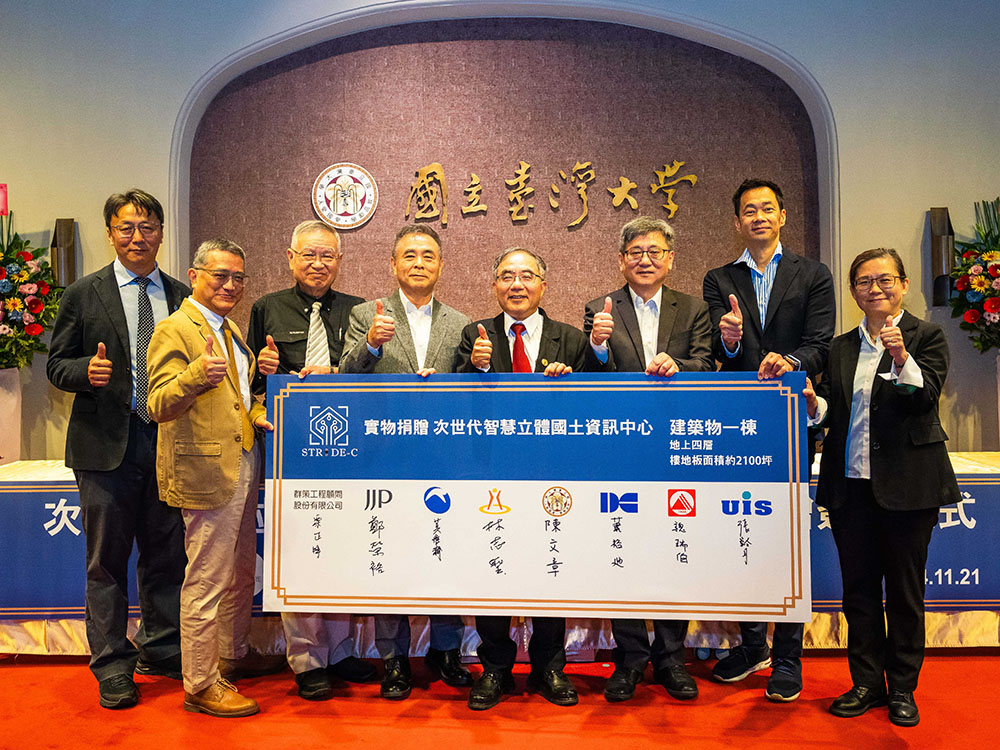
NTU wins the 2024 “National Sustainable Development Awards” for exerting influence in higher education
瀏覽器版本過舊,或未開啟 javascript
請更新瀏覽器或啟用 javascript
Spotlights
Mechanically interlocked daisy-chain-like structures as multidimensional molecular muscles. (Figure: Chang et al., Nature Chemistry 19 September 2016)
Prof. Sheng-Hsien Chiu (Forth from the left).
Inspired by the garlands of flowers crafted by children around the world, a research team of the Department of Chemistry has created supramolecular daisy chains capable of muscle-like motions that could one day power molecular machines that perform mechanical tasks in multiple dimensions. Led by Prof. Sheng-Hsien Chiu (邱勝賢), the team reported its groundbreaking research in the article, "Mechanically interlocked daisy-chain-like structures as multidimensional molecular muscles," in the September 2016 issue of Nature Chemistry.
Cyclic molecular daisy chains have long been attractive synthetic targets for supramolecular chemists because of their beautiful interlocked structures and possible muscle-like motions. In the article, the team describes the assembly of three-link molecular daisy chains ([c3]DCs) as well as four-link molecular daisy chains ([c4]DCs). The team's achievement marks the first successful exclusive synthesis of [c4]DCs from simple hermaphroditic monomers.
These interlocked [c3]DCs and [c4]DCs function as artificial muscles that perform work in multiple dimensions at the molecular level. Indeed, both of them present two possible states with different lengths between the stopping termini: a "stretched" state (longer form) and a "contracted" one (shorter form). Switching from one state to another simply occurs upon the application of a chemical stimulus (Zn2+ ions).
All three individual components of the [c3]DC can be contracted or stretched linearly on the same plane, allowing the [c3]DC to perform a two-dimensional molecular muscle-like motion. The switching of the [c3]DC between its two planar triangular structures ("stretched" and "contracted" forms) occurs with a change in "size" (as measured by the distance between its termini) of approximately 23%. By repeating the process of addition and removal of Zn2+ ions, the contraction-stretching motion can be reversibly performed for at least several times.
As for the interlocked [c4]DC, the "stretched" and "contracted" states present square- and tetrahedron-like structures, respectively. Therefore, the switching events will produce an overall three dimensional motion in such cases. The changes in the distance between the termini (36%) and the radius of the circumscribed sphere (18%) upon proceeding from the "stretched" to "contracted" state of the [c4]DC demonstrate that it might be able to mimic biological muscles, since their one-dimensional movement achieves an approximate 27% change in size.
As these new structures are artificial muscles that, unlike the one-dimensional biological muscle, contract and stretch in 2D or 3D, the development opens interesting perspectives concerning molecular machines capable of performing mechanical tasks in multiple dimensions. Notably, if the muscle-like motion of such structures can be selectively controlled in one or more dimensions, smart (i.e. stimuli-responsive) materials capable of precise changes in size or shape in 3D space at a macroscopic level, that is, totally moldable materials that can be reversibly shaped at will, would be conceivable.
This article was originally featured in NTU Highlights (December 2016).

NTU wins the 2024 “National Sustainable Development Awards” for exerting influence in higher education

Prof. Chih-Kung Lee of NTU’s Institute of Applied Mechanics elected NAI Fellow

NTU Launches Startup Initiatives at Zhubei Campus

2024 NTU-KU-UHH Trilateral Symposium: Uniting for Sustainable Future and Next Generation

Signing Ceremony for the donation of “Next-Generation Smart 3D Geospatial Information Center” at NTU Zhubei Campus
Current Spotlights